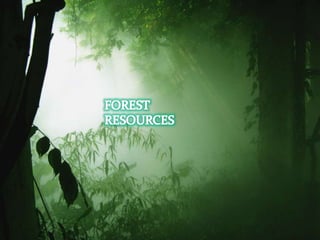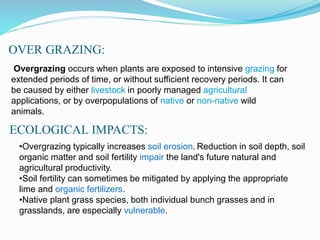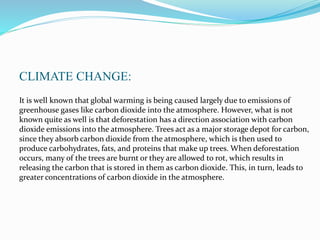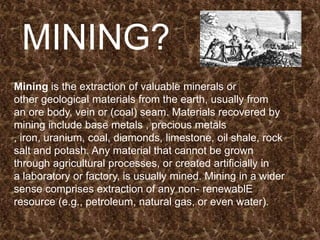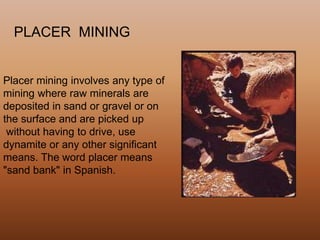Environmental Science
- 3. Introduction people began life on this planet as forest dwellers . They were food gatherers and depended on the forests for all their needs :food ,clothing and shelter. They gradually became food growers and continued depending on forests for their needs . uses of forests : •Economical uses •Ecological uses
- 4. Economical uses Fuel wood For the rural population, wood is an important source of energy for cooking and heating. They prefer smaller stems as these are easier to collect and carry. The wood that they select should be easy to split and have low moisture content to dry faster. Some of the wood is converted to charcoal and used for cooking. Fodder Fodder from the forest forms an important source for cattle and other grazing animals in the hilly and the arid regions and during a drought. There are many varieties of grasses, trees, and shrubs that are nutritious for the livestock. Care is taken to see that trees poisonous to cattle are not grown. Trees that produce a large crown above the reach of cattle are preferred.
- 5. Timber used in the manufacture of plywood , saw-milling etc Bamboo: Uses as fodder ,timber substitues,and raw material for basket,paper,pulp and small scale industries. Cane: Used to make walking sticks , polo sticks,baskets etc Grasses: Lemon grass,palmrose,khus grass are used for many food purposes. Fruit: Fruit tresss are a source of income and food for rural household. Medicinal uses: Even today man is dependent on the forest for herbs and plants to fight against disease. Of all the medicinal trees found in India, the neem is the most important. Leaves, bark, and other parts of many other trees also have medicinal value and are used to make various ayurvedic medicines
- 6. Fibr e:Soft fibres such as jute are derived from the stems of the plant. Hard fibre from the leaves of hemp and sisal are used to make fabrics for various applications. Coir, another form of fibre from the fruit of the coconut, is used to make ropes. Floss: The fruits of many species of Indian trees produce a silky floss. The most common of these is simal. It is used to made cotton wool, mattresses, and pillows. Essential oils :Oil is distilled from the wood of various species such as sandalwood, agar, and pine. Oil is also derived from the leaves of certain plants and trees such as eucalyptus, camphor, wintergreen, and pine. These oils are used for making soaps, cosmetics, incense, pharmaceuticals, and confectionery.
- 7. •Global warming is when the earth heats up (the temperature rises). •It happens when greenhouse gases (carbon dioxide, water vapor, nitrous oxide, and methane) trap heat and light from the sun in the earth’s atmosphere, which increases the temperature. •This gas, CO2, collects light and heat (radiant energy), produced by the sun, and this makes the earth warmer. •The heat and light from the sun is produced in the center of the sun. (The sun has layers just like the earth.) •Forests play a big part in keeping our planet cool. •Global warming is caused by green house gases ,one of them is carbon dioxide. •Trees “clean the air” by absorbing the carbon dioxide and giving out oxygen. •Deforestation and other ill practices increase the amount of carbon dioxide in the atmosphere ,enhancing the green-house effect. •Deforestation also increases global temperatures also leading to a change in the hydrological cycle.
- 9. Ecological uses •Fencing Fences created with trees and shrubs are preferred in developing countries as they are cheap to maintain yet give protection. Species that have thorns or are prickly and have stiff branches and leaves that are not edible are preferred. •Wind breaks and shelter belts Trees grown for wind breaks should be bushy and sturdy to withstand strong winds, both hot and cold. A species of prosopis, called P. juliflora, planted along the desert border in Haryana and Gujarat has successfully halted the advance of the desert. •Soil erosion check Tree roots bind the soil and prevent erosion caused by wind or water. Leaf fall also provides a soil cover that further protects the soil. Casuarina planted along the coastal region has helped in binding the sand and stabilizing the sand dunes in the area. •Soil improvement Some species of trees have the ability to return nitrogen to the soil through root decomposition or fallen leaves. Such trees are planted to increase the nitrogen in the soil.
- 10. Hydrological cycle It is the journey water takes as it circulates from the land to the sky and back again with various stages like •Evaporation •Transpiration •Condensation •Precipitation
- 11. •The role of forests in the water cycle is to add water to the atmosphere through the process of transpiration (where they release water from their leaves during photosynthesis). •This moisture contributes to the formation of rain clouds which release the water back on the rainforest. •In the Amazon, 50-80% of moisture remains in the ecosystem's water cycle. •When the forests are cut down, less moisture is goes into the atmosphere and rainfall declines and sometimes leads to drought.
- 13. DEFORESTATION
- 14. Deforestation refers to the loss or destruction of naturally occurring forests, primarily due to human activities such as logging, cutting trees for fuel, slash-and-burn agriculture, clearing land for livestock grazing, mining operations, oil extraction, dam building, and urban sprawl or other types of development and population expansion.
- 15. • COMMERCIAL USE • OVER-POPULLATION • FOREST FIRE • OVER GRAZING • SHIFTING CULTIVATION • GROWING FOOD NEEDS • TIMBER EXTRACTION
- 16. COMMERCIAL USE: One main reason is that the wood in those trees are needed for human consumption. The wood is used for making papers, cartons, furniture, construction materials etc. OVER-POPULATION: With the world’s population growing by leaps and bounds, there is growing demand for land use for residential, agricultural and commercial puroses. FOREST FIRE: It occurs in areas where there is little rainfall. Naturally occurring phenomena like lighting can cause forest fires. Irresponsible behavior inside the forest like not tending a camp fire or throwing a lighted cigarette is some of the reason for forest fires.
- 17. OVER GRAZING: Overgrazing occurs when plants are exposed to intensive grazing for extended periods of time, or without sufficient recovery periods. It can be caused by either livestock in poorly managed agricultural applications, or by overpopulations of native or non-native wild animals. ECOLOGICAL IMPACTS: •Overgrazing typically increases soil erosion. Reduction in soil depth, soil organic matter and soil fertility impair the land's future natural and agricultural productivity. •Soil fertility can sometimes be mitigated by applying the appropriate lime and organic fertilizers. •Native plant grass species, both individual bunch grasses and in grasslands, are especially vulnerable.
- 18. SHIFTING OF CULTIVATION Shifting cultivation is an agricultural system in which plots of land are cultivated temporarily, then abandoned. This system often involves clearing of a piece of land followed by several years of wood harvesting or farming, until the soil loses fertility. Once the land becomes inadequate for crop production, it is left to be reclaimed by natural vegetation, or sometimes converted to a different long-term cyclical farming practice.
- 19. GROWING FOOD NEEDS: •The sudden outbreak of population over the last decade has resulted in increasing demands the people . The need for food has also increased due to the increase in population. •To meet the ever rising demands of the people the existing agricultural lands are not enough .There fore a large parts of the forests have been cleared for the purpose of cultivation. •As a result trees have been cut down which causes ecological imbalance. •Trees generaaly have the tendency to absorb the carbon dioxide present in the atmosphere and maintain the carbon-oxygen cycle but now due to the lack of trees there is a disruption in the cycle causing high rates of carbon dioxide which causes the greenhouse effect and rise in the average temperature of the surface of the earth.
- 21. CLEAR FELLING: Clear felling generally means complete destruction of the native forest, modifying it by harvesting commercial trees to create an even aged group and removing non commercial trees, if needed. Now, commercial timber logging is being done through clear felling all over the world. SELECTIVE LOGGING: In selective logging, only large individual trees of a few economically marketable species are harvested, leavin the others for the next harvest season. Even so, the damage done may be as high as 50% of the total forest area, due to the need of creating access routes, dragging cut trees to the forest floor and lack of planning.
- 22. MECHANIZED LOGGING: In mechanized logging, heavy machinery are used to pull, lift and transport the trees. This process can be used in clear felling or selective logging operations. HAND LOGGING: Local people use hand logging for non-commercial felling of timber or for clearing the forest for agriculture. They use hand held chain saws and the trees are pulled manually. This method is used in peat-swamped forests, which are heavily water logged, and heavy machinery movement is not possible. REDUCED-IMPACT LOGGING: Reduced impact logging is now a common feature in industrialized nations where environmental damage can be minimized through the selection of site sensitive techniques of harvesting and logging.
- 23. • FLOOD AND DROUGHTS • SOIL EROTION • DISRUPTION OF WATER CYCLE • LOSS OF BIO-DIVERSITY • CLIMATE CHANGE
- 24. One of the vital functions of forests is to absorb and store great amounts of water quickly when there are heavy rains. When forests are cut down, this regulation of the flow of water is disrupted, which leads to alternating periods of flood and then drought in the affected area FLOOD AND DROUGHTS: SOIL EROSION: Forest soils are moist, but without protection from sun-blocking tree cover they quickly dry out making it very dry and eventually, infertile, due to volatile nutrients such as nitrogen being lost. In addition, when there is rainfall, it washes away the rest of the nutrients, which flow with the rainwater into waterways. This causes soil erosion.
- 25. DISRUPTION OF WATER CYCLE: Trees also help perpetuate the water cycle by returning water vapor back into the atmosphere. Without trees to fill these roles, many former forest lands can quickly become barren deserts. LOSS OF BIO-DIVERSITY: Removing trees deprives the forest of portions of its canopy, which blocks the sun’s rays during the day and holds in heat at night. This disruption leads to more extreme temperatures swings that can be harmful to plants and animals.
- 26. CLIMATE CHANGE: It is well known that global warming is being caused largely due to emissions of greenhouse gases like carbon dioxide into the atmosphere. However, what is not known quite as well is that deforestation has a direction association with carbon dioxide emissions into the atmosphere. Trees act as a major storage depot for carbon, since they absorb carbon dioxide from the atmosphere, which is then used to produce carbohydrates, fats, and proteins that make up trees. When deforestation occurs, many of the trees are burnt or they are allowed to rot, which results in releasing the carbon that is stored in them as carbon dioxide. This, in turn, leads to greater concentrations of carbon dioxide in the atmosphere.
- 28. MINING? Mining is the extraction of valuable minerals or other geological materials from the earth, usually from an ore body, vein or (coal) seam. Materials recovered by mining include base metals , precious metals , iron, uranium, coal, diamonds, limestone, oil shale, rock salt and potash. Any material that cannot be grown through agricultural processes, or created artificially in a laboratory or factory, is usually mined. Mining in a wider sense comprises extraction of any non- renewablE resource (e.g., petroleum, natural gas, or even water).
- 29. PLACER HYDRAULIC OPEN PIT HARD ROCK
- 30. Placer mining involves any type of mining where raw minerals are deposited in sand or gravel or on the surface and are picked up without having to drive, use dynamite or any other significant means. The word placer means "sand bank" in Spanish. PLACER MINING
- 31. HYDRAULIC MINING: Hydraulic mining involves high pressure water. The water is sprayed at an area of rock and/or gravel and the water breaks the rock up, dislodging ore and placer deposits. The water/ore mixture is then milled. This is a very destructive way to mine and has been outlawed in most areas.
- 32. HARD ROCK Hard rock mining entails digging into solid rock to fine minerals usually in their ore form (the metal plus oxygen). To do this, miners used picks and shovels, rock drills, dynamite and more Miners dug either shafts that went straight down to follow ore bodies and veins, or tunnels which went somewhat horizontal into rock faces. Most shaft or tunnel mines would eventually flood as they hit the water table and water would have to be continually pumped out. Sometimes there was so much water they had to abandon the mines.
- 33. OPEN PIT Open pit mines involve digging large open holes in the ground as opposed to a small shaft in hard rock mining. Open pit mines are very large and devastate the surrounding landscape as can be seen in this picture of the Bingham Canyon Mine near Tooele, Utah. Mining operations of this scale were not done too often in the 19th century.
- 36. Effecton environment: Mining requireslarge areas of land to be clearedso that theearthcouldbe duginto by the miners.Forthisreason,large scale deforestationis required to be carriedoutin the areaswheremining has to be done.Besidesclearing themining area, vegetation in the adjoiningareas alsoneedsto be cut in orderto constructroadsand residential facilitiesfor themine workers.The humanpopulationbringsalong with it otheractivitiesthat harmthe environment. LossofBiodiversity: The foreststhat are clearedfor mining purposesare home to a large numberof organisms. Indiscriminateclearing of the forestsleadto lossof habitat of a largenumberof animals.The cutting down of treesin itself is a big threat to a number of plantsand treesgrowing in the forests. Pollution: Despite measures beingtaken to release the chemicalwaste intothe nearbyriversthrough pipes,a large amount of chemicalsstill leakoutontothe land.This changesthe chemicalcompositionof the land.Besidesthis,since the chemicals are poisonous,they makethesoilunsuitable for plantsto grow.
- 37. EFFECT ON WATER: Pollution: Chemicals like mercury,cyanide,sulphuricacid,arsenicand methylmercuryare usedin various stagesof mining.Most of the chemicals are releasedintonearbywaterbodiesthat leadsto waterpollution.In spite of tailings(pipes) being usedto dispose these chemicalsinto thewaterbodies,possibilitiesof leakage are alwaysthere.Whenthe leakedchemicalsslowlypercolatethrough thelayersof the earth,theyreachthe groundwater and pollute it. LossofAquaticLife: Release of toxicchemicalsintothe wateris obviouslyharmfulfor thefloraand fauna of the waterbodies.Besidesthe pollution,miningprocessesuse water fromnearbywatersources.The resultis that the watercontent of the riveror lake fromwhichwateris beingusedgetsreduced.Organismsin these waterbodies do not have enough water for their survival.
- 38. SPREAD OF DISEASES: Sometimestheliquidwastethatis generatedafterthemetalsor mineralshavebeen extractedisdisposedina miningpit.As the pitgetsfilledup by theminetailings, theybecomea stagnantpoolof water.Thisbecomesthebreedinggroundforwater- bornediseasescausinginsectsandorganismslikemosquitoesto flourish. The effectsinsuchcasescanbe devastatingforthe environment.Be it dueto ignoranceof theregulationsor justa freakaccident, incidentsliketheGuyanaspillof 1995highlightsthefactthatissueslikehowdoesminingaffecttheenvironmentare worthsomeseriousdeliberation.

